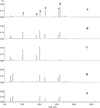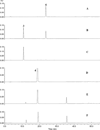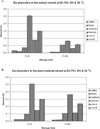Stability evaluation of selected polyphenols and triterpene glycosides in black cohosh
- PMID: 18817410
- PMCID: PMC11750054
- DOI: 10.1021/jf802481w
Stability evaluation of selected polyphenols and triterpene glycosides in black cohosh
Abstract
Black cohosh ( Actaea racemosa L., syn. Cimicifuga racemosa L.) is rich in both triterpene glycosides and polyphenols, which have various biological activities that may be important to its medical use. To evaluate the stability of the polyphenolic constituents and triterpene glycosides of black cohosh, experiments were conducted using three sample types: plant material, extracts of black cohosh, and encapsulated commercial extract. The samples were stored at various temperatures and humidity conditions. Three triterpene glycosides and six major polyphenols in black cohosh were quantitatively measured with an HPLC-PDA method at 0, 3, 6, and 9 weeks. The triterpene glycosides were stable at the tested conditions, whereas the polyphenols were stable only at room temperature and low humidity and not stable at higher temperature and/or humidity due to hydrolysis and/or oxidation. The rate of compound decomposition depended upon the chemical structure of the individual polyphenols. Polyphenols in the extracts decomposed more readily than those in plant material.
Figures




Similar articles
-
Phytochemical fingerprinting to thwart black cohosh adulteration: a 15 Actaea species analysis.Phytochem Anal. 2011 Jul-Aug;22(4):339-51. doi: 10.1002/pca.1285. Epub 2011 Feb 19. Phytochem Anal. 2011. PMID: 21337649
-
Evaluation of the botanical authenticity and phytochemical profile of black cohosh products by high-performance liquid chromatography with selected ion monitoring liquid chromatography-mass spectrometry.J Agric Food Chem. 2006 May 3;54(9):3242-53. doi: 10.1021/jf0606149. J Agric Food Chem. 2006. PMID: 16637680 Free PMC article.
-
Stability of black cohosh triterpene glycosides and polyphenols: potential clinical relevance.Phytomedicine. 2013 Apr 15;20(6):564-9. doi: 10.1016/j.phymed.2012.12.011. Epub 2013 Feb 14. Phytomedicine. 2013. PMID: 23415548 Clinical Trial.
-
[Efficacy and safety of Black cohosh (Actaea/Cimicifuga racemosa) in the treatment of vasomotor symptoms--review of clinical trials].Ginekol Pol. 2008 Apr;79(4):287-96. Ginekol Pol. 2008. PMID: 18592868 Review. Polish.
-
Ethnobotany, Phytochemistry, Traditional and Modern Uses of Actaea racemosa L. (Black cohosh): A Review.Adv Exp Med Biol. 2021;1308:403-449. doi: 10.1007/978-3-030-64872-5_24. Adv Exp Med Biol. 2021. PMID: 33861455 Review.
Cited by
-
Pregnane X receptor-mediated induction of Cyp3a by black cohosh.Xenobiotica. 2011 Feb;41(2):112-23. doi: 10.3109/00498254.2010.527021. Epub 2010 Oct 27. Xenobiotica. 2011. PMID: 20979450 Free PMC article.
-
Comparison of Drying Techniques for Extraction of Bioactive Compounds from Olive-Tree Materials.Foods. 2023 Jul 12;12(14):2684. doi: 10.3390/foods12142684. Foods. 2023. PMID: 37509775 Free PMC article.
-
Unraveling the anti-breast cancer activity of Cimicifugae rhizoma using biological network pathways and molecular dynamics simulation.Mol Divers. 2025 Feb;29(1):241-254. doi: 10.1007/s11030-024-10847-3. Epub 2024 Apr 13. Mol Divers. 2025. PMID: 38615110
-
Working with the natural complexity: Selection and characterization of black cohosh root extract for use in toxicology testing.Food Chem Toxicol. 2022 Feb;160:112769. doi: 10.1016/j.fct.2021.112769. Epub 2021 Dec 18. Food Chem Toxicol. 2022. PMID: 34929352 Free PMC article.
-
Benefits of Black Cohosh (Cimicifuga racemosa) for Women Health: An Up-Close and In-Depth Review.Pharmaceuticals (Basel). 2022 Feb 23;15(3):278. doi: 10.3390/ph15030278. Pharmaceuticals (Basel). 2022. PMID: 35337076 Free PMC article. Review.
References
-
- Borrelli F, Izzo AA, Ernst E. Pharmacological effects of Cimicifuga racemosa. Life Sci. 2003;73:1215–1229. - PubMed
-
- Kronenberg F, Fugh-Berman A. Complementary and alternative medicine for menopausal symptoms: A review of randomized, controlled trials. Ann. Intern. Med. 2002;137:805–813. - PubMed
-
- Rossouw JE, Anderson GL, Prentice RL, LaCroix AZ, Kooperberg C, Stefanick ML, Jackson RD, Beresford SA, Howard BV, Johnson KC, Kotchen JM, Ockene J. Risks and benefits of estrogen plus progestin in healthy postmenopausal women: Principal results from the women's health initiative randomized controlled trial. J. Am. Med. Assoc. 2002;288:321–333. - PubMed
-
- Anderson GL, Limacher M, Assaf AR, Bassford T, Beresford SA, Black H, Bonds D, Brunner R, Brzyski R, Caan B, Chlebowski R, Curb D, Gass M, Hays J, Heiss G, Hendrix S, Howard BV, Hsia J, Hubbell A, Jackson R, Johnson KC, Judd H, Kotchen JM, Kuller L, LaCroix AZ, Lane D, Langer RD, Lasser N, Lewis CE, Manson J, Margolis K, Ockene J, O'Sullivan MJ, Phillips L, Prentice RL, Ritenbaugh C, Robbins J, Rossouw JE, Sarto G, Stefanick ML, Van Horn L, Wactawski-Wende J, Wallace R, Wassertheil-Smoller S. Effects of conjugated equine estrogen in postmenopausal women with hysterectomy: The women's health initiative randomized controlled trial. J. Am. Med. Assoc. 2004;291:1701–1712. - PubMed
-
- Blumenthal M. The ABC Clinical Guide to Herbs. Austin Texas: American Botanical Council; 2003. pp. 13–409.
Publication types
MeSH terms
Substances
Grants and funding
LinkOut - more resources
Full Text Sources
Miscellaneous

